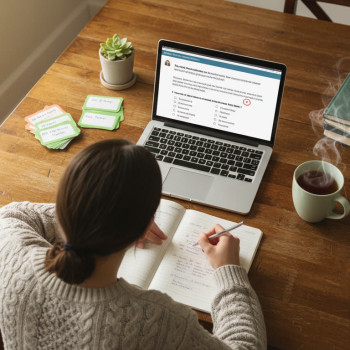Introduction: Why an 18-Month Plan Works
Switching from IGCSE to Advanced Placement (AP) courses is an exciting leap: deeper subject matter, different exam styles, and an opportunity to earn college credit. If you’re wondering how to make that leap without burning out, an 18-month plan is ideal. It gives you time to build foundations, experiment with subjects, and arrive at your first two AP exams confident and well-prepared.
This guide is written for students (and their parents) who want a calm, strategic, and human-centered roadmap. It blends study structure, practical tips, example timelines, and real-world context so you know what to do and when. I’ll also point out where personalized help—like Sparkl’s 1-on-1 guidance and tailored study plans—can amplify your progress.
Overview: The Big Picture (Months 1–18)
The 18 months split naturally into three phases: Exploration and Foundation (Months 1–6), Consolidation and AP Coursework (Months 7–12), and Exam-Focused Mastery (Months 13–18). You’ll pick your two AP subjects early, then use the first months to strengthen IGCSE foundations and build study habits that scale.
Why not rush?
AP classes reward depth and practice. Rushing into two APs without scaffolding often means fragile understanding and last-minute cramming. The 18-month plan prevents that by layering knowledge, skills, and exam practice at a sustainable pace.
Phase 1: Exploration and Foundation (Months 1–6)
Goal: Identify strengths and interests, shore up gaps from IGCSE, and set routines.
Month 1–2: Self-Assessment and Subject Selection
Start by asking practical questions: Which subjects do I enjoy? Which classes align with my university goals? Which AP exams are typically accepted for credit at your target colleges? Pick two APs you feel motivated to learn—one that builds on a strong IGCSE subject and one that’s a stretch but manageable.
- Example pairings: IGCSE Math → AP Calculus AB; IGCSE Physics → AP Physics 1; IGCSE English → AP English Language.
- If unsure, choose one STEM and one humanities/social science to balance workload and cognitive styles.
Month 3–4: Fill the Gaps
Use these months to strengthen core skills that APs assume. For Math, review algebra and trigonometry. For sciences, reinforce data interpretation and lab basics. For English and history, practice close reading and evidence-based writing.
Small, daily habits beat sporadic marathons: 30–45 minutes of focused study, 4–5 days a week. Build a study schedule that includes practice questions, brief content review, and weekly reflection on progress.
Month 5–6: Test-Taking Foundations
AP exams reward not only content knowledge but also test skills: timing, question interpretation, and evidence-based writing. Start practicing the following:
- Multiple-choice timing drills (20–30 questions under timed conditions).
- Short free-response or essay practice—focus on structure and clarity.
- Note-taking and concept-mapping from textbooks and lectures.

Phase 2: Consolidation and AP Coursework (Months 7–12)
Goal: Start or deepen AP coursework, build disciplined weekly routines, and gather practice materials.
Month 7–9: Begin AP Curriculum and Regular Practice
If your school offers AP classes, enroll in them now. If you’re self-studying, choose a structured curriculum (textbook + syllabus outline + past exam questions). Split weekly time roughly as:
- 60% content learning (textbook, class, videos)
- 30% applied practice (homework, problems, lab reports)
- 10% reflection and test skills (timed items, reviewing mistakes)
Rotate focus days: heavy content on two days, practice-heavy days on two days, and light review or catch-up on one day. Reserve weekends for one longer practice block.
Month 10–12: Expand Depth, Introduce Past Exams
Start integrating AP past exam questions and scoring rubrics into your weekly routine. Practice full free-response questions under timed conditions and grade them against the official rubric (this trains you to hit the right elements). Keep a mistake log: what concept caused errors, and how can you fix it?
Phase 3: Exam-Focused Mastery (Months 13–18)
Goal: Sharpen exam strategy, simulate test conditions, and consolidate weak areas so you’re exam-ready.
Month 13–15: Intensify Practice and Review
Shift the ratio toward practice: 40% content review, 50% practice, 10% meta-learning (strategy and mental prep). Take a full-length practice exam for each AP under timed conditions every 4–6 weeks, then follow up with targeted study on weak areas.
- Use the scoring rubrics to self-evaluate and aim to reduce careless mistakes.
- Practice writing succinct, evidence-backed essays with clear introductions and conclusions.
Month 16–17: Final Drills and Exam Simulation
Begin weekly full-length practice exams for each AP, alternating subjects to avoid fatigue. Simulate test-day conditions: start at the same hour, use only allowed materials, and take scheduled breaks. Track performance trends—if a section consistently dips, create a 2-week micro-plan to fix it.
Month 18: Taper, Polish, and Confidence-Building
In the final 2–3 weeks before your exam, taper heavy new learning. Focus on:
- Light review of high-yield concepts and formulas
- 2–3 timed question sets per week
- Mindset and logistics: sleep schedule, breakfast plan, and materials check
Rest and confidence are as important as last-minute review. A calm, practiced student usually outperforms a frantic one.

Sample 18-Month Timeline Table
| Months | Focus | Key Activities |
|---|---|---|
| 1–2 | Self-Assessment | Choose APs, map IGCSE overlap, create weekly schedule |
| 3–4 | Fill Gaps | Review essential IGCSE material, strengthen fundamentals |
| 5–6 | Test Skills | Timing drills, short FRQ practice, note-taking habits |
| 7–9 | Begin AP Coursework | Start class/self-study, weekly practice, lab work |
| 10–12 | Past Questions | Integrate official past exams, build mistake log |
| 13–15 | Intense Practice | Monthly full exams, targeted review, rubric-based grading |
| 16–17 | Simulation | Weekly full exams, examine trends, final micro-plans |
| 18 | Taper & Exam | Light review, logistics, rest, test day |
Weekly and Daily Routines That Actually Work
The secret isn’t studying more hours—it’s using them well. Here’s a sample weekly template for busy students juggling school, extracurriculars, and life:
- Weekdays: 45–60 minutes after school focused on that week’s AP topic (alternate subjects on different nights).
- Two evenings: timed practice or essay writing (30–50 minutes).
- Weekend: one 2–3 hour block for deeper review, labs, or a full practice section; one day light or social recovery.
- Monthly: one full practice exam under test conditions per AP during consolidation, increasing frequency during final phase.
Study Session Structure (45–60 minutes)
- 0–10 min: Quick warm-up and review of previous mistakes.
- 10–35 min: Focused learning or practice (one concept or set of problems).
- 35–50 min: Timed questions or short writing practice.
- 50–60 min: Reflection and short plan for next session.
How to Choose Your Two AP Subjects
Selection matters. Balancing passion, college plans, and realistic workload creates the best outcomes.
- Follow a Strength: If you excelled in IGCSE Biology, AP Biology is a natural choice—and you’ll save time on foundational review.
- Mix One Stretch With One Comfort: Pair a challenging subject you want to grow in with one you can manage confidently.
- Consider College Goals: Some majors prefer certain APs (e.g., STEM majors often value Calculus and Physics). But don’t over-optimize—genuine understanding matters more than a long AP list.
- Logistics: Check exam dates and your school’s ability to support coursework. Balance lab requirements and long writing assignments across semesters.
Practice Smart: Quality Over Quantity
Not all practice is equal. Here are high-leverage practices that produce the most gain:
- Active Retrieval: Try to recall information before re-reading. Closed-book practice forces memory and reveals gaps.
- Spaced Repetition: Revisit concepts over increasing intervals to cement them in long-term memory.
- Interleaved Practice: Mix problem types instead of focusing on a single type for hours; this builds flexible thinking.
- Rubric-Aligned Writing: When practicing essays, use the AP rubrics as your checklist—address every point explicitly.
Using Resources Wisely
Your materials should include a clear syllabus, a reliable textbook or two, a collection of past free-response questions, and timed multiple-choice sets. A spaced schedule of official past exams is one of the most powerful tools for calibration.
If you have access to personalized tutoring, take advantage: a skilled tutor can diagnose blind spots, give targeted practice, and sharpen exam strategies. Sparkl’s personalized tutoring—1-on-1 guidance, tailored study plans, expert tutors, and AI-driven insights—can be particularly useful for staying on track and getting individualized feedback when classroom pacing isn’t enough.
How Parents Can Support Without Doing the Work
Parents play a huge role by creating structure and support. Helpful actions include:
- Helping design a sustainable weekly calendar and keeping fixed commitments visible.
- Encouraging healthy routines: consistent sleep, good nutrition, and physical activity.
- Providing emotional encouragement: celebrate small wins and normalize setbacks.
- Investing in targeted help (tutors, practice materials) when a student is stuck.
Common Pitfalls and How to Avoid Them
Knowing the traps helps you sidestep them:
- Overloading Subjects: Two APs is a reasonable start; adding more too soon often lowers overall performance.
- Neglecting Fundamentals: Don’t skip the fundamentals that IGCSE built—AP exams assume a stable foundation.
- Ignoring Exam Practice: Content without exam practice leads to poor time management and missed points.
- Perfection Paralysis: 100% mastery before moving on is unrealistic. Aim for steady progress and iterative improvement.
Mindset: The Quiet Engine of Success
AP prep is as much psychological as intellectual. Cultivate a growth mindset: mistakes are feedback, not failure. Track progress with measurable indicators (practice test scores, reduced careless errors) rather than vague feelings.
When motivation dips, return to purpose: college goals, passion for the topic, or the satisfaction of mastering something challenging.
Final-Stage Checklist (2–3 Weeks Before Each Exam)
- Complete at least two full, timed practice exams per AP under test conditions.
- Review your mistake log; create a short “do-not-forget” sheet of essential formulas, key dates, or literary devices.
- Plan test-day logistics: arrival time, materials, and a calm pre-test routine.
- Schedule lighter study six days before and rest fully the day before the exam.
Real Student Example (Composite Case)
Meet Aisha, an IGCSE student who chose AP Calculus AB and AP English Language as her first two APs. She spent Months 1–6 shoring up algebra and practicing rhetorical analysis. In Months 7–12 she took a school AP class for Calculus and self-studied English with weekly timed essays. Months 13–18 focused on repeated practice exams and a mistake log. By exam day she had a strong command of procedural math and concise essay structure—she felt calm and prepared. Aisha used occasional 1-on-1 tutoring with Sparkl to target stubborn algebra errors and to refine her essay feedback, which accelerated her progress without adding pressure.
Parting Advice: Keep Perspective
AP scores matter, but so does the learning journey. An 18-month plan gives you time to develop durable skills that serve beyond a single test: critical thinking, disciplined study, and the ability to learn independently. If you can build those, the AP scores will follow—and so will confidence for whatever comes next.
Quick Reference: Tools and Practices to Consider
- Official practice exams and rubrics for calibration.
- Smart note systems: Cornell notes, concept maps, or a digital flashcard deck.
- Regular timed practice and mistake logs for continuous improvement.
- Targeted tutoring or coaching when plateaus appear—choose 1-on-1 help for personalized feedback.
Closing: You’ve Got This
Transitioning from IGCSE to AP is a milestone, and doing it with an 18-month plan gives you space to grow with intention. Keep your goals clear, your schedule kind to your mental health, and your study methods active and evidence-based. As you work toward your first two AP exams, remember that steady, well-directed effort beats frantic cramming every time.
If you’d like, use this plan as a template—adapt the timeline to your school calendar and personal pace. And when you want targeted feedback, consider adding occasional 1-on-1 sessions (Sparkl’s personalized tutoring is one example) to keep your momentum and sharpen your strategies. Best of luck—one step at a time, you’ll get there.


















No Comments
Leave a comment Cancel